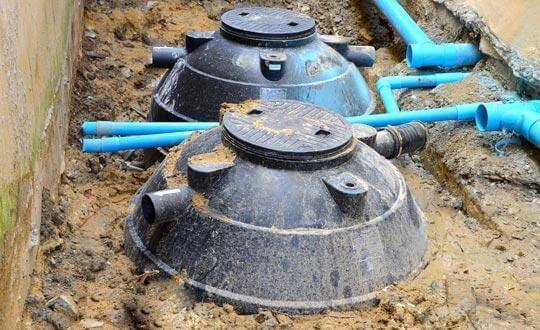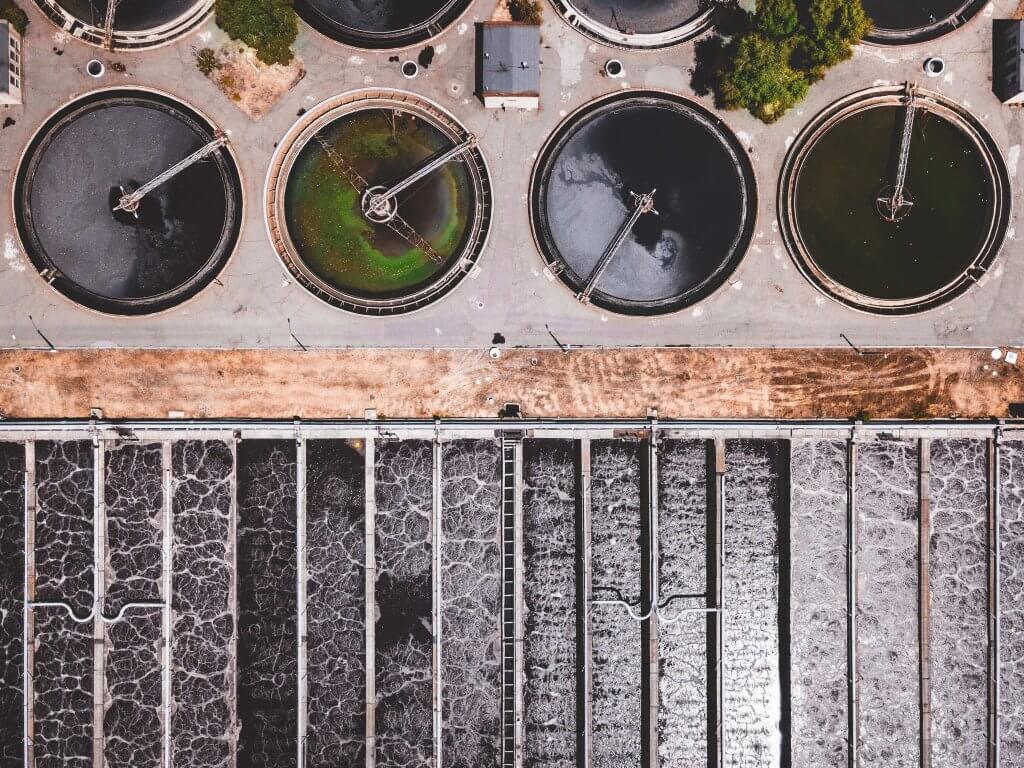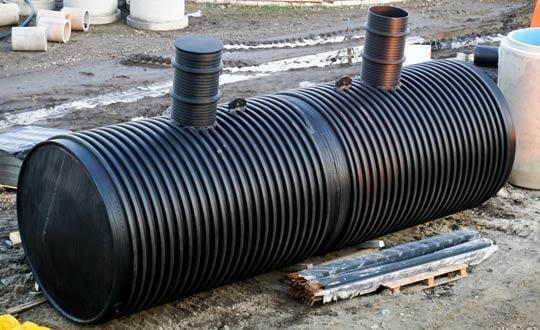Types of Sewage Treatment Plants
Sewage treatment plants are off-mains waste removal systems that allow you to safely and efficiently dispose of sewage and wastewater through an environmentally friendly process.
Sewage treatment plants can be built to meet a wide variety of needs and environmental requirements, and they can be designed for a 2-person domestic flat or for a 100-person commercial office.
This variety means that there are many different types of sewage treatment plant to consider for your property or business. There are electric plants and non-electric plants, plastic plants and fibreglass plants, there are activated sludge plants and sequential batch reactor plants…
To explain more, we asked our experts to give us a rundown of the most popular types of sewage treatment plant that can be installed in the UK.

What Is a Sewage Treatment Plant?
Sewage treatment plants are an off-mains system designed to treat sewage and wastewater independently of public sewers. They break down household waste in a similar way to septic tanks, but produce a cleaner, more environmentally friendly effluent that can be safely discharged into local water sources.
While there are an increasing number of companies offering different designs and types of sewage treatment plant, they all use the same principles to break down waste. Household waste enters the sewage treatment plant and naturally occurring bacteria are used to breakdown harmful compounds to produce a clean discharge. Sewage treatment plants circulate oxygen, often using an electric motor or compressor, to ensure this process is as efficient as possible.
What Are the Main Types of Sewage Treatment Plants?
Sewage treatment plants aren’t just the major public sewage treatment works you’re probably imagining. They can be designed for small households or scaled up to meet larger demands.
In most cases, sewage treatment plants are electrically powered, although there are a few models that can be run without power. Most are built underground and all are connected to a property using a series of pipes.
The different types of sewage treatment plant generally fall into the following major categories:

● ASP: activated sludge plants
● FBBR: fixed bed bioreactors
● MBBR: moving bed bioreactors
● Non-electric sewage treatment plants
● Rotating disc systems
● SBR: sequential batch reactors
Different types of sewage treatment plant have different components, moving parts and construction materials. There’s no single sewage treatment plant that’s best suited for all scenarios, as they vary in size, capacity, power usage and output. So it’s good to know what your options are if you’re having one installed.
What Are the Key Differences Between Them?
Let’s take a look at the key differences between these major types of sewage treatment plant to get a better understanding of which design might be best suited for your requirements.
Activated Sludge Plants
Activated sludge plants are one of the most popular types of sewage treatment plant on the market, as they’re cost effective, versatile and highly effective.
The activated sludge process uses aeration to provide bacteria with the oxygen they need to breakdown waste. This is achieved through an electric compressor that pumps air into the system.
Treated sludge is settled in a separate part of the system, and the clean wastewater can be siphoned off separately. This type of plant needs constant electricity to work, but once the system is set up it needs little maintenance or interference.
Fixed Bed Bioreactors
Fixed bed bioreactors use the same aeration principles to circulate oxygen for bacteria. However, they also have an additional filter media built into the system.
This filter media is constructed from plastic and ensures that the wastewater produced is of an extremely clean quality. The filters are covered in biofilm, which provides a suitable habitat for the bacteria needed to break down the waste.
Fixed bed bioreactors allow waste to be re-circulated where necessary to ensure it meets high environmental standards before it’s discharged from the tank.
FBBRs are built partly above and partly below ground, and often take up more space and involve higher running costs than activated sludge plants. They do produce an exceptionally clean effluent, however.
Moving Bed Bioreactors
Moving bed bioreactors are almost exactly the same as fixed bed reactors, as they make use of a plastic filter media to improve the cleanliness of the effluent produced by the plant.
The major difference is that the filter media and biofilm aren’t fixed in one location, but are loose within the tank. The filter media moves through the system, while compressors pump air in to sustain the bacteria.
Moving bed bioreactors are compact but highly concentrated, allowing you to save space while producing an exceptionally high-quality discharge.
Non-Electric Sewage Treatment Plants
Non-electric sewage treatment plants are self-contained systems that don’t require any electrical power to operate. They use the same aeration principles as active sludge plants, and often have a biofilm media installed to make the process more efficient.
Non-electric sewage treatment plants rely on filtration and gravity rather than compressors and pumps, which is why they don’t require electricity.
However, not every location is suitable for this type of system. They only work in locations where the discharge can be immediately ejected, otherwise the effluent pools at the bottom due to gravity and needs to be pumped out mechanically (which requires electricity and defeats the object of the plant!).
Rotating Disc System
A rotating disc system, or rotating biological contactor, is an effective type of sewage treatment plant that consists of rotating discs covered in biofilm. This compact system first separates solids and liquids, then passes the liquid into a second chamber where the discs continually rotate.
The rotating discs produce a large surface area, allowing high quantities of liquid to be treated in a short space of time. The effluent is treated to a high standard, but with multiple moving parts and the need for a continual supply of electricity, repair and running costs are higher than other types of sewage treatment plant.
Sequential Batch Reactors
Sequential batch reactors work by treating set quantities of waste individually. Rather than treating a continual supply of waste that’s pumped into the system, an SBR treats waste in batches. The treatment plant consists of separate, self-contained chambers, where a set quantity is allowed in, treated, then released to the next stage, where it’s sealed in, treated, and so on.
The system is very effective, as it ensures that all the waste is adequately treated before being passed onto the next stage. SBRs are controlled by a computer interface, which allows users to set the timings for batch treatments and to maximise efficiency. It’s cost-effective once installed, but the initial upfront costs are higher than other systems.
How Do I Decide Which Sewage Treatment Plant I Need?
Different types of sewage treatment plant have different advantages and disadvantages. Some are big, some are compact, some are more efficient than others, and some produce a more environmentally friendly effluent. When deciding which is best for you, you first need to establish your requirements.
You need to consider a number of factors before deciding on a sewage treatment plant:

● What’s your budget for installation and running costs?
● Do you have access to electricity?
● How much waste do you need to treat?
● How much space do you have for the installation?
● Do you need the plant to be hidden below ground?
● Are you discharging close to areas of environmental concern?
● How clean does the effluent need to be?
Compare your needs to the features and benefits of particular sewage treatment plants to see if the system is going to fulfil your requirements and prove to be a safe and cost-effective investment in the long term.
Regardless of the particular type of system you choose, you always need to ensure that the system meets the following specifications to be legally compliant:
● CE Marked: to prove the sewage treatment plant meets safety standards.
● EN 12566-3 tested and certified.
● Permit to Discharge and the ability to meet effluent discharge standards in your local environment.
What’s the Best Type of Sewage Treatment Plant?
As you can see, there isn’t one type of sewage treatment plant that can fulfil every single requirement. The best sewage treatment plant for you depends on your budget, the quantity of waste you need treating, and how clean you need the waste to be.
All sewage treatment plants are best made to order, ensuring that individual circumstances can be taken into account. We suggest contacting a sewage treatment plant specialist for expert advice and recommendations.
Contact OMDI Today for Your Free Quote
OMDI has years of experience designing, installing and maintaining sewage treatment plants and other off-mains waste-disposal systems. Our expert team can advise on the best types of sewage treatment plant for your needs.
Our team is just a phone call or email away, so don’t hesitate to get in touch to find out more about our sewage treatment plant design, installation and repair services. Contact OMDI today for your free quote.
